
How To Create An Email Marketing Calendar In 2025 [+Template]
A well-planned email marketing calendar is your ticket to engaging your audience and keeping your marketing team organized.
With a consistent schedule, you’ll build trust and keep your brand top of mind. Plus, it allows you to plan a variety of emails—newsletters, promotions, and personalized messages—so your content stays fresh and relevant.
In this guide, we’ll cover the key components of an email calendar, how to set it up effectively, and some essential tools to help you out, from creation to scheduling.
Schedule your emails effortlessly
Select stunning templates, customize to your brand, hit “send.”
Try for freeWhat is an Email Marketing Calendar?
An email calendar is a vital tool for organizing your email marketing campaigns, detailing what needs to be delivered and who is responsible for each task.
It should be updated regularly so your marketing team knows exactly what to do and when. In a nutshell, a calendar will streamline your email marketing strategy, keeping everything on track and well-organized.
Email Marketing Calendar Components
The easiest way to organize your email calendar is with an Excel spreadsheet or Google Sheets document. You can add all the necessary details and share the file with your colleagues and team members.
Your calendar should include:
- Campaign name
- Email owner
- Campaign status
- Target email list
- Send time
Below you can see a simple example of an email calendar:
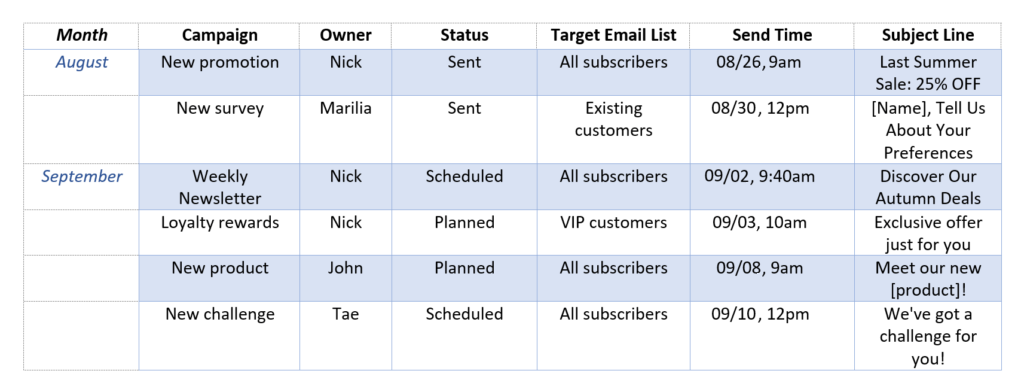
Email Calendar Template
If you’re not a fan of starting from scratch, you can use free email calendar templates. To help you out, we’ve created one just for you.
For the full version, click the button below and make a copy. Then, customize the template to fit your needs by adding or removing elements.
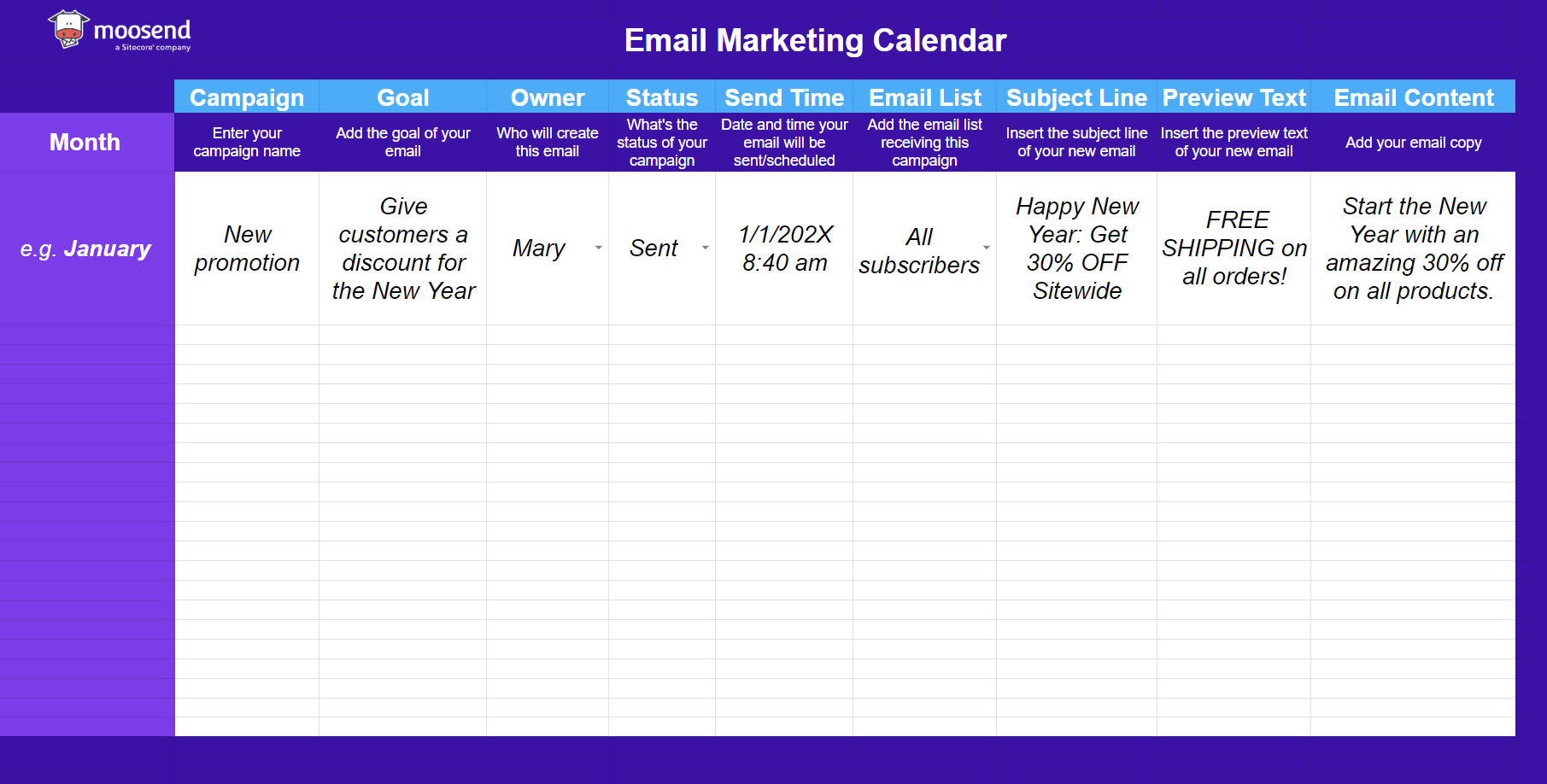
How to Create an Effective Email Marketing Calendar
Below, you’ll find the essential steps to create your email calendar and make your email marketing efforts easier.
1. Decide what email campaigns to send
When starting email marketing, the first step is to decide what types of emails you want to create and send.
Your choice of campaigns shouldn’t be arbitrary. For example, B2C organizations often focus on product-oriented campaigns with deals, discounts, and more, while B2B businesses may have different needs. Let’s explore the most important email types and workflows you can set up for both to give you an idea.
For B2C companies:
- Weekly email newsletters
- New product launches
- Promotional emails
- Seasonal campaigns
Here’s a product launch email marketing campaign by Patagonia:

And here are the most popular emails for B2B organizations:
- Blog content promotions
- Email surveys
- Free trials and follow-ups
- Webinars
Below you can see a webinar marketing email example by Growthhackers:
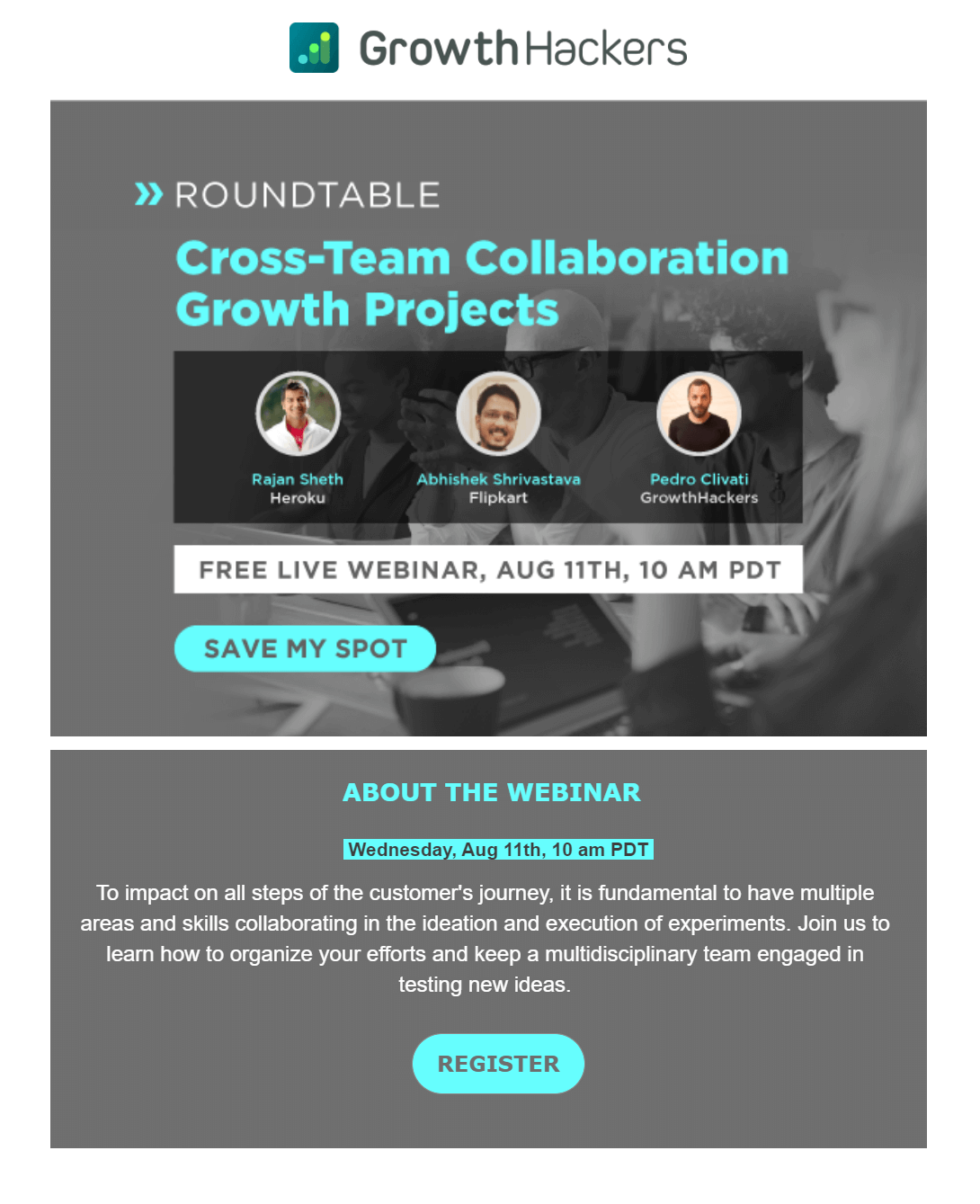
In addition to industry-specific emails, companies should deliver essential messages to nurture and convert their email lists.
Here are the key emails that both B2C and B2B marketers should set up:
- Welcome emails
- Re-engagement campaigns
- Confirmation messages
- Announcement campaigns
You can create all of the above with an advanced email marketing automation tool like Moosend or Mailchimp.
2. Create a tab with important holidays
To stay on top of things, you can also create a separate tab in your email marketing calendar to track key dates you can target.
You can find a dedicated holiday section in our email calendar template:
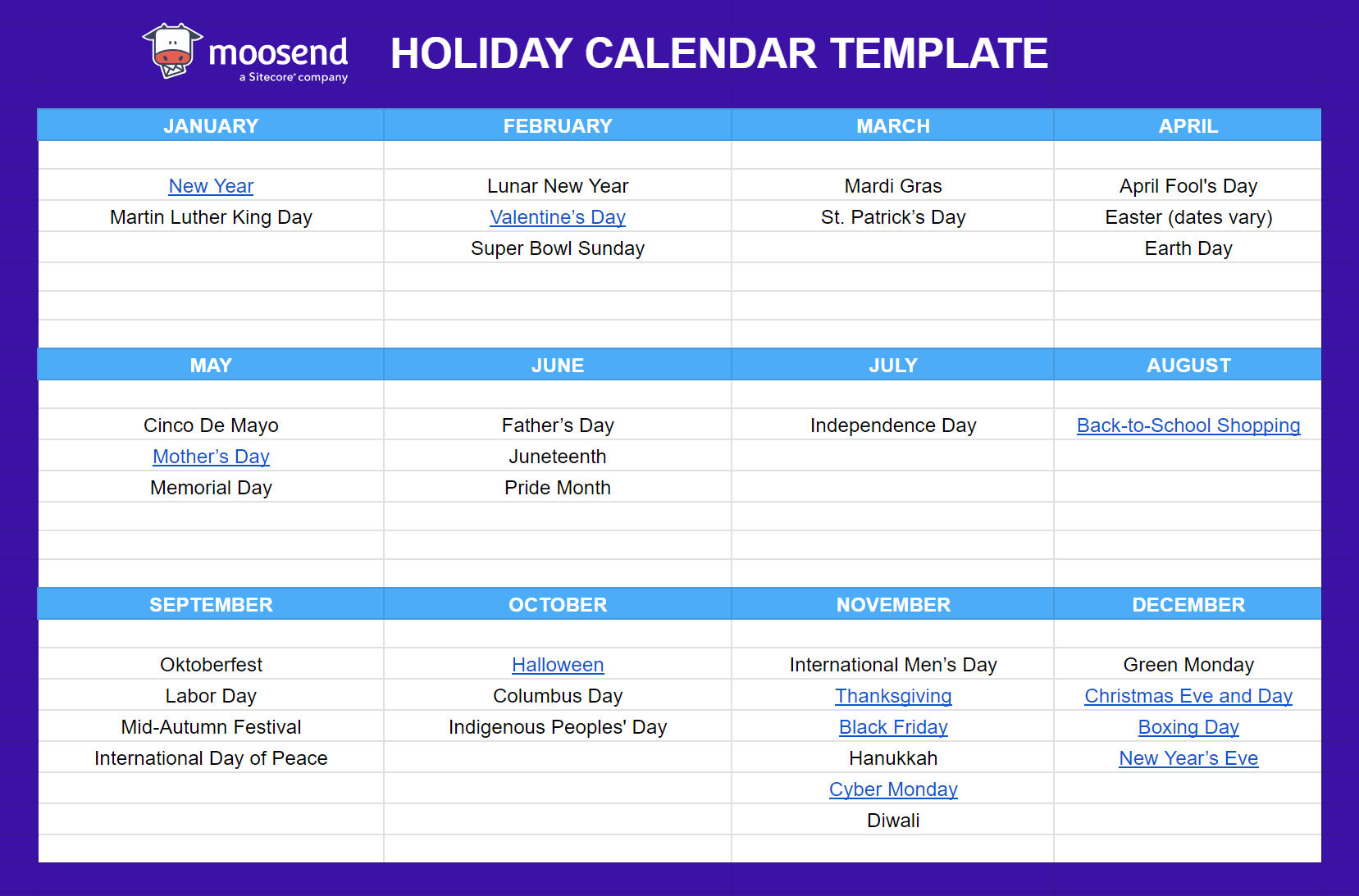
For example, you can plan email campaigns around Mother’s Day, Valentine’s Day, Black Friday, Christmas, and more.
Here are a few helpful resources to help you with your seasonal email campaigns:
- A Step-by-Step Mother’s Day Email Marketing Guide [+Examples]
- Black Friday Email Marketing: Strategy & Tips
- Top 20+ Christmas Email Marketing Examples
Need a helping hand with your email designs? Make sure to choose a dedicated holiday newsletter template to save time and effort!
3. Assign email owners
While it might seem feasible for one person to handle every email marketing campaign, assigning different team members to specific emails is more efficient.
By giving each campaign a designated owner, you’ll save time as they can create content faster. This approach also allows team members to understand how to craft emails that effectively convert your audience.
For example, assigning Mary to your promotional and product launch campaigns will allow her to focus on this type of email and improve the effectiveness of these messages.
As a result, you’ll build an efficient email marketing funnel that will run smoothly.

But how do you find the right people for each campaign? Just make sure that all of your email owners:
- Know how to use your email marketing service
- Are aware of the objectives of each campaign
- Have knowledge of the target email list and their pain points
After you find the best person for the job, you can start setting your marketing goals.
Tip: To have better team control and encourage team collaboration, it would be useful to use team collaboration software. These tools will save you from potential problems and increase employee productivity.
4. Set goals for each campaign
Speaking of goals, once you’ve decided on the type of content and emails you want to send, you need to set specific marketing objectives.
Goal-setting is a crucial component of a successful email marketing strategy. Start by creating SMART goals for your email campaigns. This model helps you clearly define what you want to achieve, how to do it, and, ultimately, assess whether you’ve met your objectives.

Now let’s see an example.
SMART Goal Summary: I will create an email campaign for my new product launch.
- Specific: I’ll craft an email message to promote my business’s new product.
- Measurable: The goal is to increase brand awareness, excite my customers, and solve their pain points.
- Attainable: We can promote our new item by creating an engaging email campaign for our subscribers and potential customers. If we make the message intriguing, our email list will click on our call-to-action and check it out.
- Relevant: I want my email marketing team to create a campaign that speaks to our target audience, communicating the immediate benefits of acquiring the new product.
- Time-bound: The campaign/s should be created and scheduled before and after the new launch to get more people interested and lead them to action.
After performing this simple task, you can add your objectives to your email marketing calendar for your team members to see:
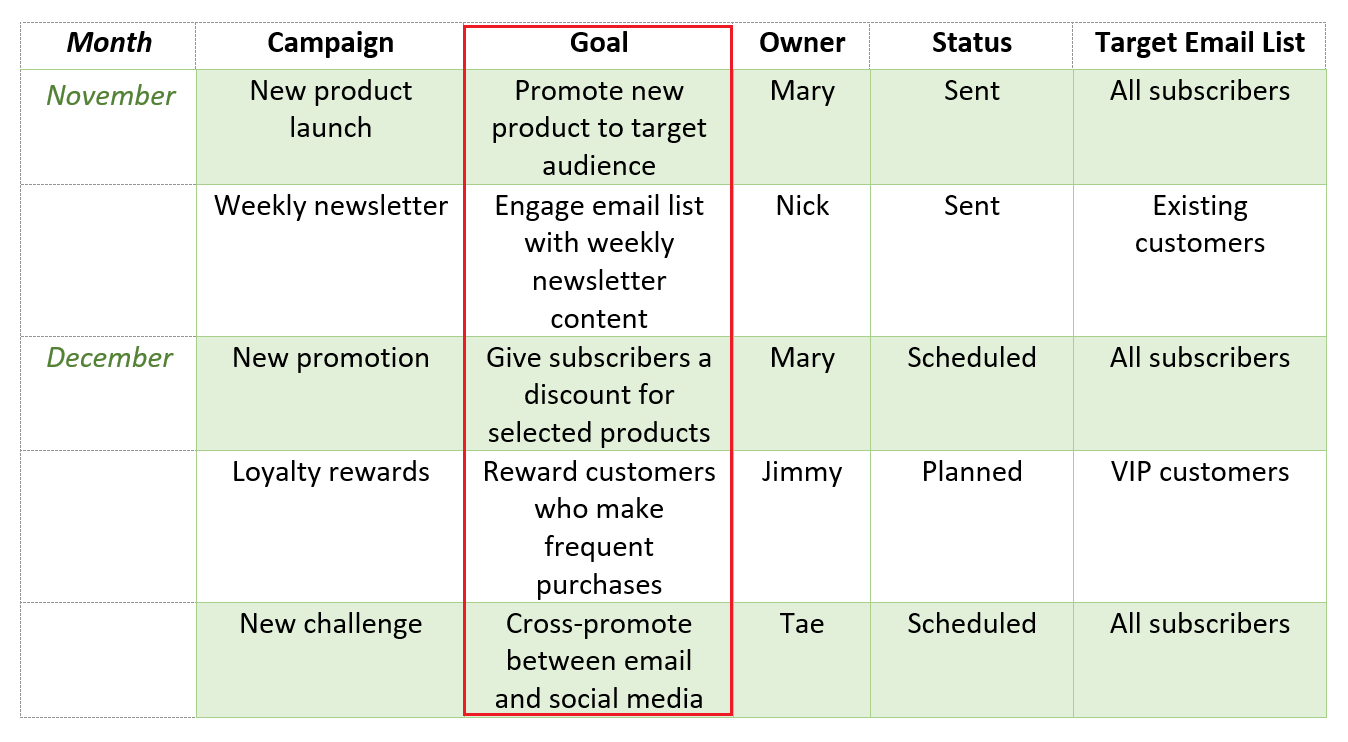
5. Find the best time to send your emails
The next step in organizing your email campaign calendar is to determine the best send dates and times.
To do so, you need to consider a few things first, like your:
- Subscribers’ age and gender
- Recipients’ device
- Email list time zone
This will help you find an efficient sending schedule for your audience. And while this process is more of a trial and error, you can rely on existing data to help you develop a consistent plan.
For instance, here are some of the best and worst sending times and days to help you out:
- Best day and time: Thursday – from 9 am to 11 am.
- Worst day and time: Saturday – from 4 pm to 5 am.
This info should be included in your calendar view by your email owners, so you know when your campaigns roll out:
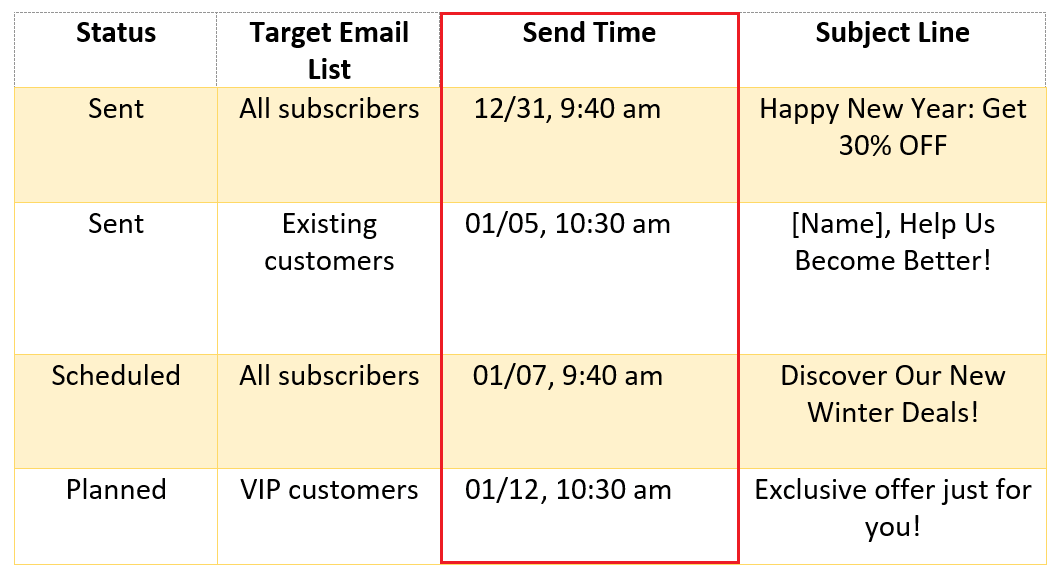
Also, this process will allow you to check your sending time consistency and create a high-performing content marketing strategy to nurture and convert your audience.
6. Target the right segment
I’m sure you’ve already heard about the power of email segmentation. If not, this process allows you to divide your email subscribers into focused groups based on similar interests.
For instance, you can segment your audience according to demographics, location, age, gender, etc. The goal is to create groups of people with common interests and then leverage the data to send them targeted messages.

For small businesses and eCommerce stores, this will power up your engagement efforts and allow you to target your email list with the right message at the right.
You can create a variety of customer segments right from the start. All you need to do is add the necessary fields in your newsletter sign-up forms.
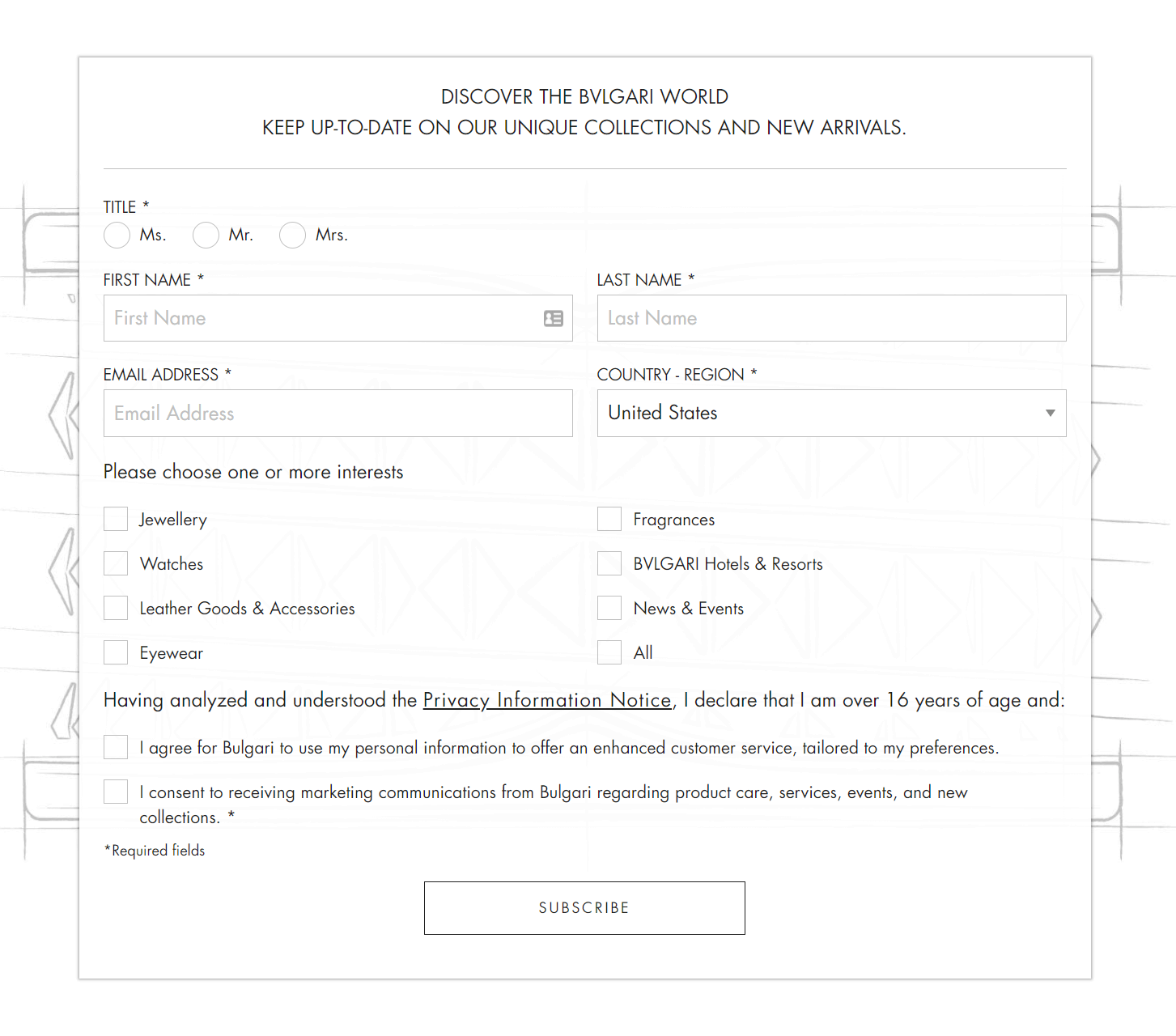
As you can see, Bulgari manages to segment their new subscribers by dividing them according to:
- Their location (Country – Region)
- Gender (Title) and marital status for women (Ms./Mrs.)
- Interests (Jewellery, Watches, etc.)
Using this type of customer data will help you target each stage of the customer journey more effectively and create an email marketing plan that will perform!
7. Craft compelling email subject lines
After setting your goals, selecting your campaign types, and segmenting your list, you can start working on your emails.
The first and most important step is crafting an intriguing subject line that drives high open rates.
Since your subject lines affect your engagement, you should add them to your email calendar. This way, you can track what you’ve sent and avoid repeating similar lines that might bore your audience.
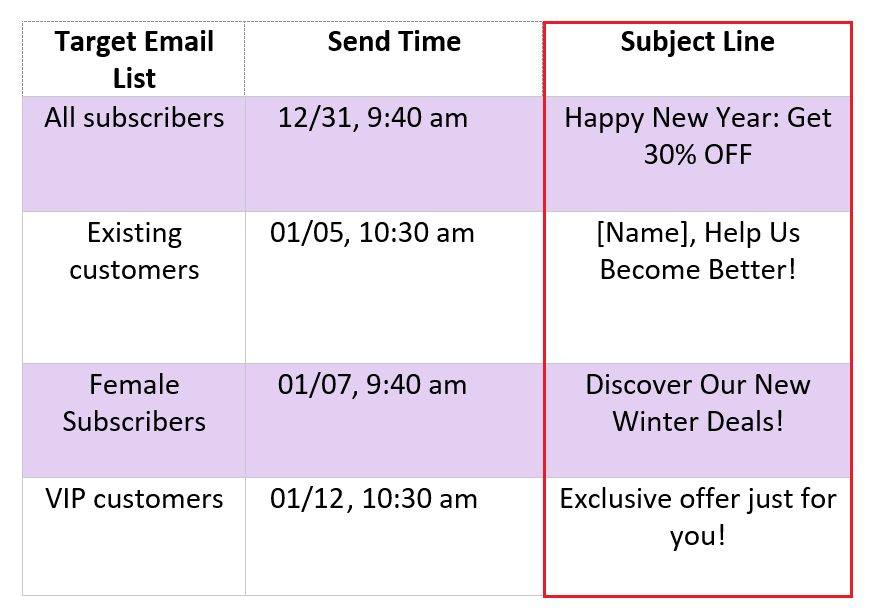
To ace your subject lines, you need to:
- Add actionable language
- Show the immediate benefit
- Keep them short (40-50 characters)
- Avoid spammy words and use urgency
If subject lines are a challenge for you, consider using a subject line tester to help out. For example, Refine is a tool that analyzes your copy’s performance and offers valuable tips to boost your open rates.
8. Design valuable email content
Once your subscribers click on your campaigns, they need to find a message that’s worth their time!
Tap into your creativity and email copywriting skills to craft compelling content that guides your audience toward the desired action.
Here are a few key points to keep in mind when crafting your messages:
- Personalize your content to appeal to your subscriber
- Use clear and actionable language
- Add a straightforward CTA button
- Highlight the immediate benefits
When you are done, you can add your email content to your email marketing calendar:
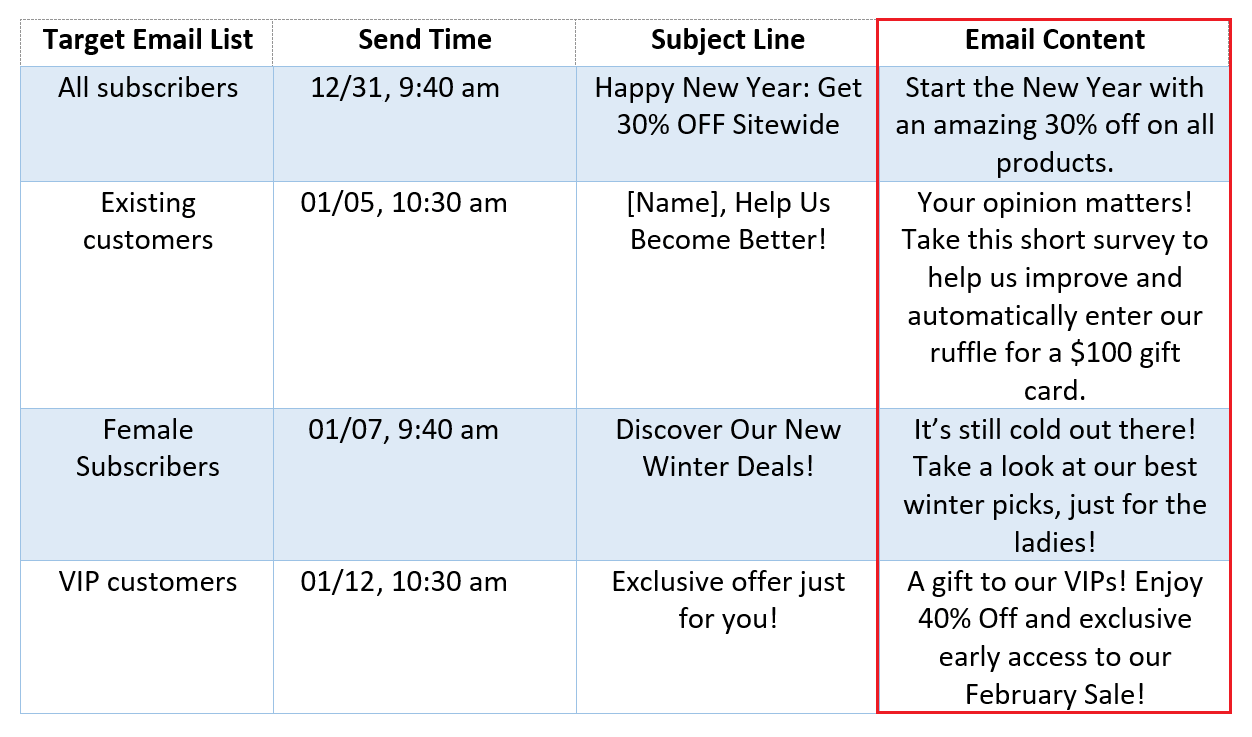
Adding an Email Content column will allow you to check what your audience receives and make your feedback process and proofreading efforts easier.
On top of that, you can copy-paste the content and use it to create seamless landing pages for your email list. That’s two birds with one stone.
9. Update the status of your campaigns
Keeping your calendar up-to-date is one of the most time-consuming tasks you’ll come across.
However, if you don’t want to have an underperforming calendar, you need to frequently update your data, and more specifically, your campaign status:
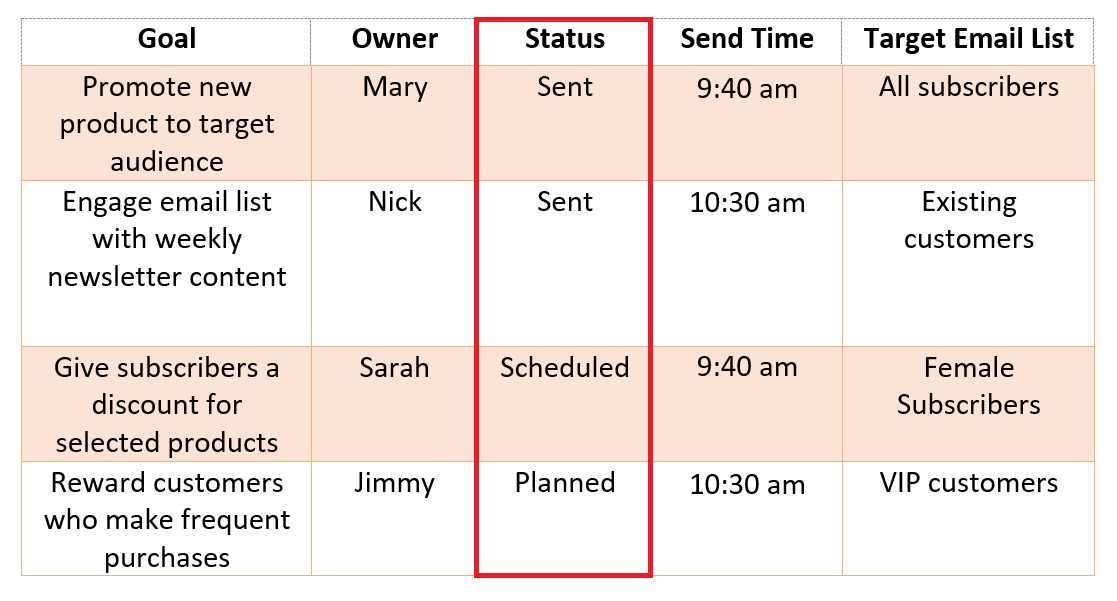
To avoid confusion, make sure to label your completed campaigns with “Sent” (or any other indicator). Also, you can schedule future campaigns and add those you plan to send to keep your team informed about your email marketing plan.
Need help scheduling your emails? Moosend’s email tool will allow you to set a specific date and time for your messages.
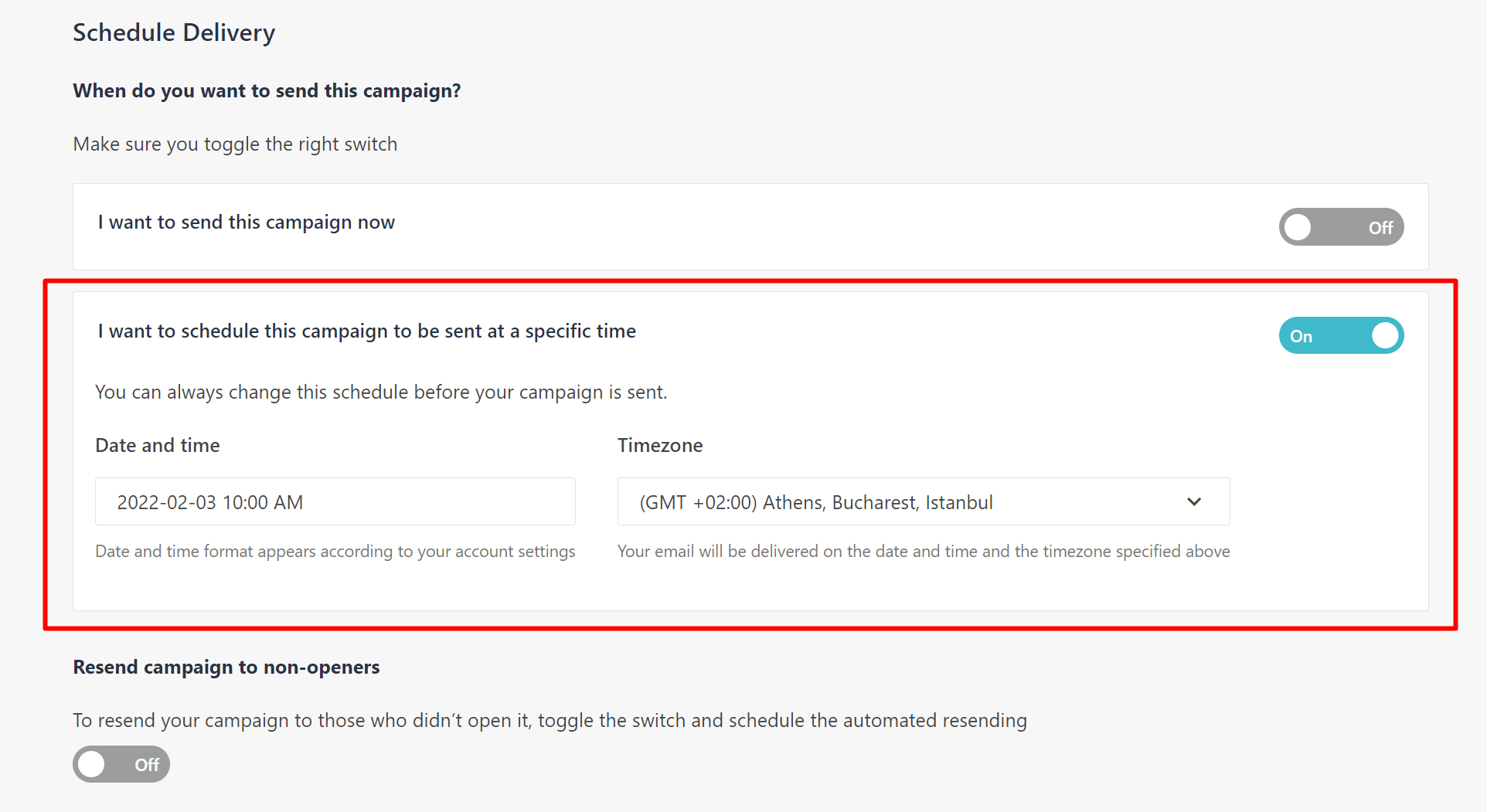
You can try the feature by signing up for an account and heading to Schedule Delivery, where you can select the date, time, and time zone.
10. Measure campaign performance
Until now, we’ve seen the important elements of a great email marketing calendar. To take it a step further, you can also include additional data to give your team an overview of their email campaign performance.
To do so, you need to track important email metrics like your email open rate, click-through rate, conversions, and more. This information will help your email marketers improve their creations, from the subject lines to the email content.
![]()
Above, you can see some of the most popular email campaign metrics you can include in your calendar, including device type and unsubscribes.
Of course, you can add any indicators you like according to your goals. For instance, you can also insert your:
- Email deliverability
- Leads generated from each campaign
- Revenue earned per email
- Click-to-open rate
11. Add your A/B testing results
Improving your campaign performance is essential for boosting engagement and achieving revenue goals.
Use A/B testing to identify the best elements for your audience. Testing different versions of your subject lines, content, and visuals will reveal what resonates most with your recipients.
Document the results in your email calendar, along with the data collected, to refine future campaigns.
Essential Tools for Your Email Marketing Calendar
Now that you know how to create an email campaign calendar that’s more organized than Marie Kondo’s apartment, let’s explore a few marketing tools to help streamline your efforts.
Moosend – Schedule Email Delivery
Moosend is your friendly email marketing platform, allowing you to create, automate, and send your campaigns to your audience. The tool will allow you to craft beautiful and responsive emails using a drag-n-drop builder with advanced elements.
On top of that, it will give you the ability to schedule your emails. This means that you can plan your email campaigns through the editor, select your recipients, and schedule them for a later date and time.
Best features
- Schedule delivery option
- Email preview and delivery testing tools
- Real-time reporting and analytics
- Automated workflows and pre-made recipes
Pricing: Moosend features a free trial you can try by signing up here for unlimited email campaigns with up to 1,000 subscribers. Paid plans start at $9/month, giving you access to the SMTP server, landing pages, team members, and more.
Google Sheets – Plan Your Calendar
Google Sheets allows you to organize your schedule and data in simple spreadsheets. You can use the tool for free when you create a personal Gmail account or find it in Google Workspace (formerly G Suite) for Businesses for additional security and team control.
Google Sheets is a simple tool to help you plan your email marketing calendar; it is accessible and easy to use.
Best features
- Share with your team members
- Built-in formulas and conditional formatting
- Variety of add-ons
- Excel compatibility (Chrome extension or app)
Pricing: Google Sheets is free to use along with Docs and Slides when you register for a Gmail account. For businesses, Google Workspace paid plans start at $6/user/month with the Business Starter.
Trello – Email Calendar Planning & Visualization
Trello is a content management tool that will help you visualize your email calendar through lists and cards. You can create and share boards with your teammates.
What’s more, it sports an array of built-in automation features, allowing you to streamline project management and minimize tedious tasks.
Best features
- Multiple boards
- Easy-to-set-up workflows
- Codeless automation
- Integrations with various apps
Pricing: Trello is free for individuals or teams who want all the simple functions to nail their projects. Then, paid plans start at $5/user/month with the Standard, offering more features.
Zapier – Data Exchange Between Apps
Zapier is an automation tool that will help you integrate your favorite apps. Through Zaps, you can exchange data between your applications and streamline your efforts.
For your email calendar, you can set up a variety of workflows that will send data directly to your Google Sheets, keeping everything organized and up-to-date without having to add it manually.
Best features
- Integration with more than 3,000 apps
- Easy-to-set-up workflows
- Variety of triggers and actions
Pricing: Zapier has a free plan for 100 tasks a month and 5 Zaps. Then, pricing starts at $29.99/month, giving you 750 tasks and 20 Zaps.
Jotform – Email Marketing Calendar Templates
Jotform is an online form builder tool that also offers various templates you can use to build your email calendar, social media calendar, or marketing plan.
The tool will allow you to customize your template and add new columns and rows to create a calendar that will have all your data.
Best features
- Various table templates
- Integrated calendar
- Online form builder
Pricing: Jotform has a free plan you can use for 5 online forms. For more, you need a paid plan, starting with the Bronze at $39/month, the Silver at $49, and the Gold at $129 per month.
Plan Your Email Marketing Calendar
An organized email calendar will help you create a high-performing email marketing strategy that will work on autopilot.
To make it successful, follow the steps outlined above and use helpful tools like Moosend, which you can try for free, along with Google Sheets, Trello, and others to streamline your process and simplify campaign management.
Additionally, it’s important to keep your email and content calendars in sync to ensure consistent messaging and timing across all channels.
If you need some help with your calendar, you can easily grab and customize our email calendar template. With that in mind, it’s time to create the best calendar for your newsletters.
FAQs
Below you’ll find answers to some common questions regarding email calendars.
1. How do I make an email marketing calendar?
Start by listing all your planned campaigns and key dates. Use a tool like Excel, Google Sheets, or a dedicated calendar software to organize this information. Include details like campaign names, email owners, target audiences, and send dates. Update the calendar regularly to keep your team aligned and ensure timely delivery.
2. How do I schedule an email marketing campaign?
Scheduling an email marketing campaign involves selecting the right send date and time for your audience. Use your email marketing platform to set up automated sends, ensuring your emails go out when they’re most likely to be opened. Consider time zones, audience behavior, and campaign goals when deciding on your schedule.
3. How does an editorial calendar differ from an email calendar?
An editorial calendar outlines the overall content strategy, including blog posts, social media updates, and other content types. An email calendar, on the other hand, focuses on your email marketing campaigns. Syncing these calendars ensures consistent messaging and timing across all channels, helping to create a cohesive and effective marketing strategy.
4. What are the 7 email marketing strategies?
The 7 key email marketing strategies include:
- Segmentation: Divide your audience into specific groups for targeted messaging.
- Personalization: Tailor content to individual recipients for higher engagement.
- Automation: Use automated workflows to send emails at optimal times.
- A/B testing: Test different email elements to find what works best.
- Mobile optimization: Ensure emails look great on mobile devices.
- Content creation: Provide valuable, relevant content to your audience.
- Analytics: Regularly analyze email performance and adjust your strategy accordingly.
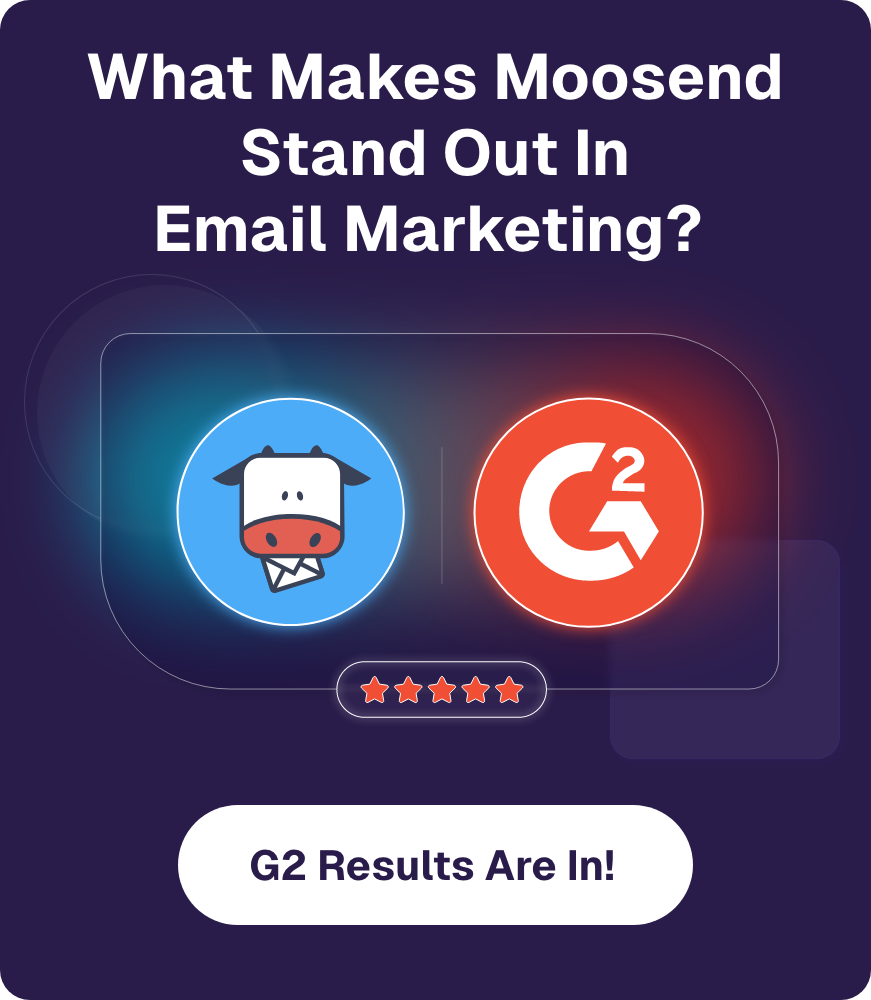



 Published by
Published by

 Published by
Published by
